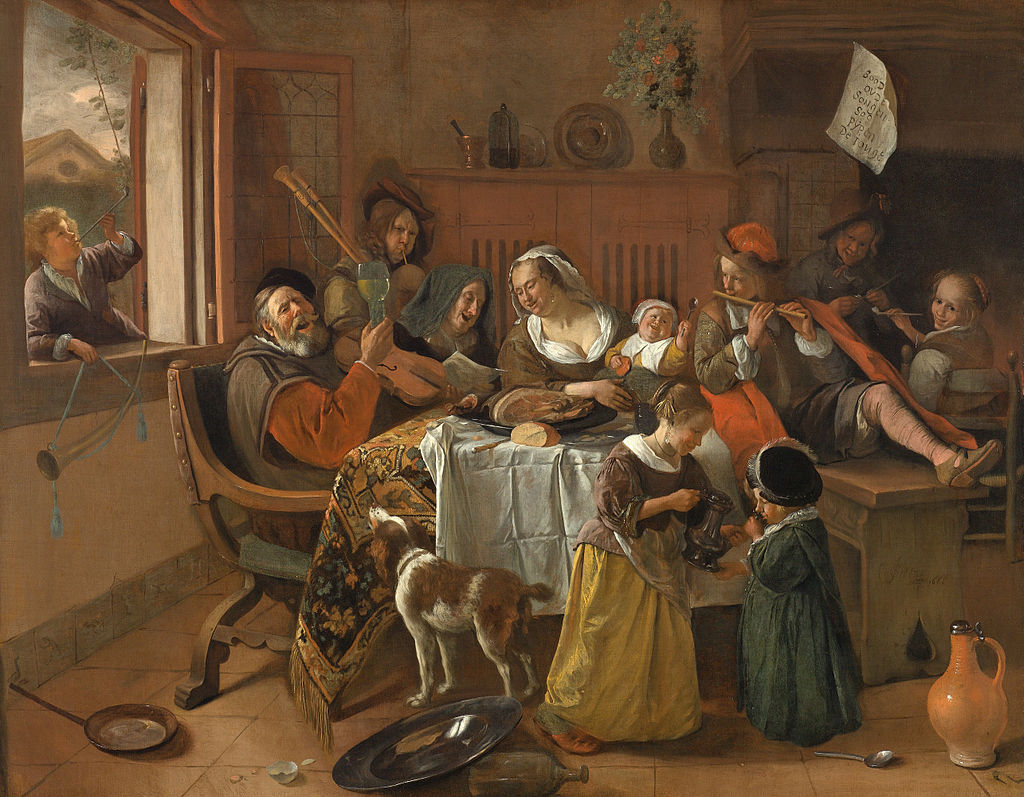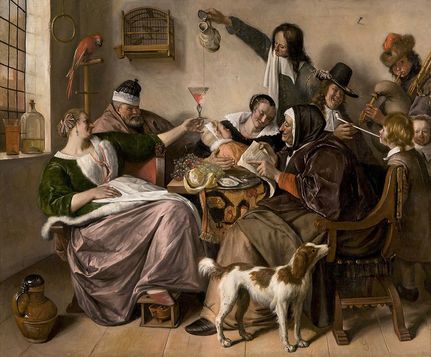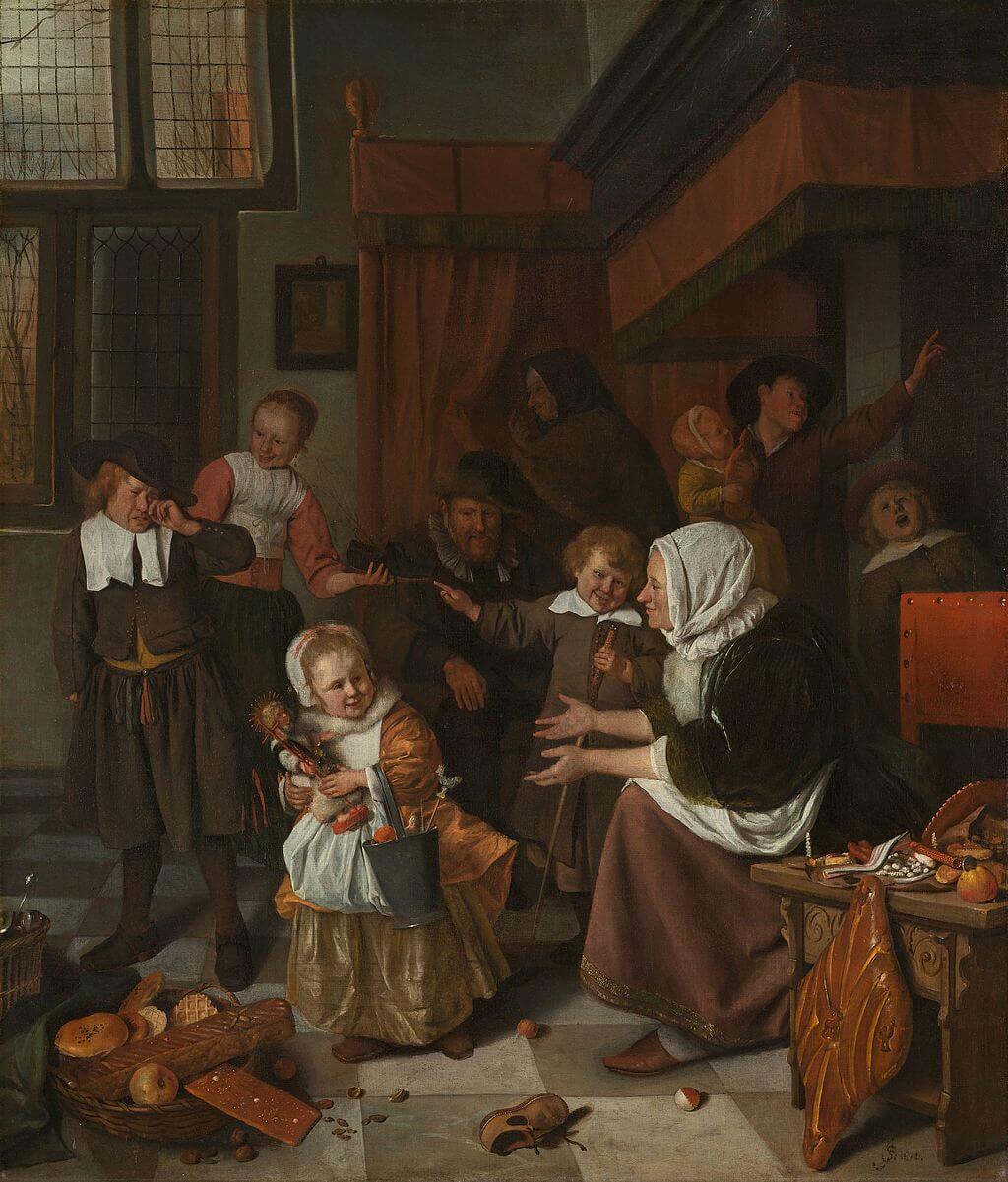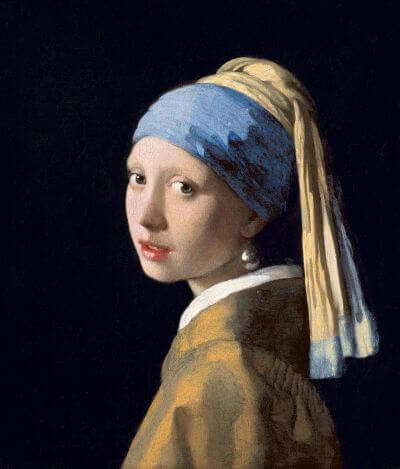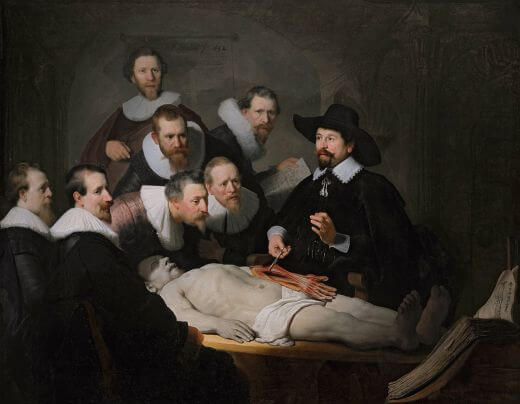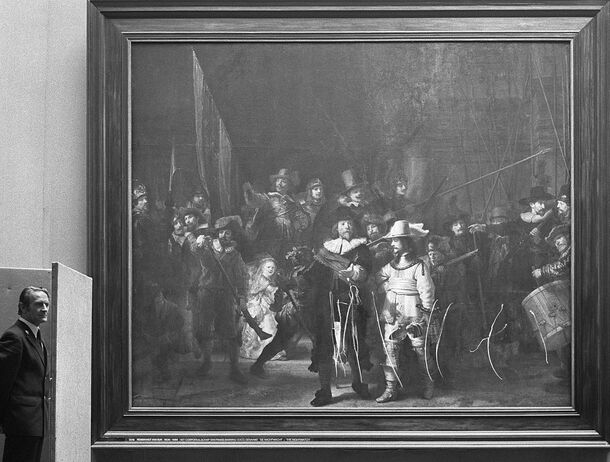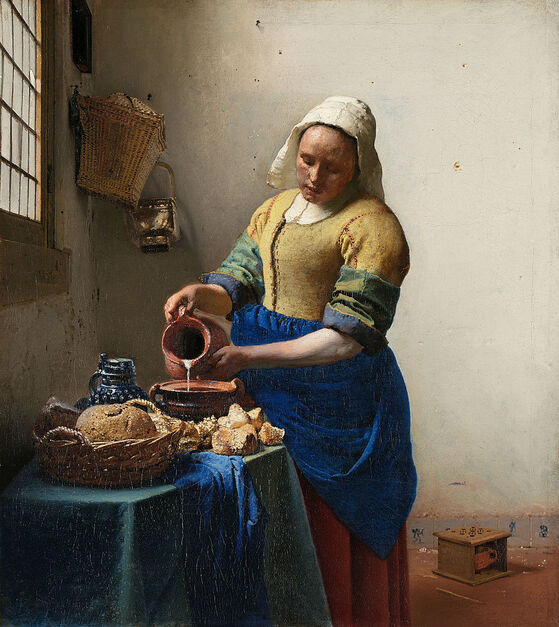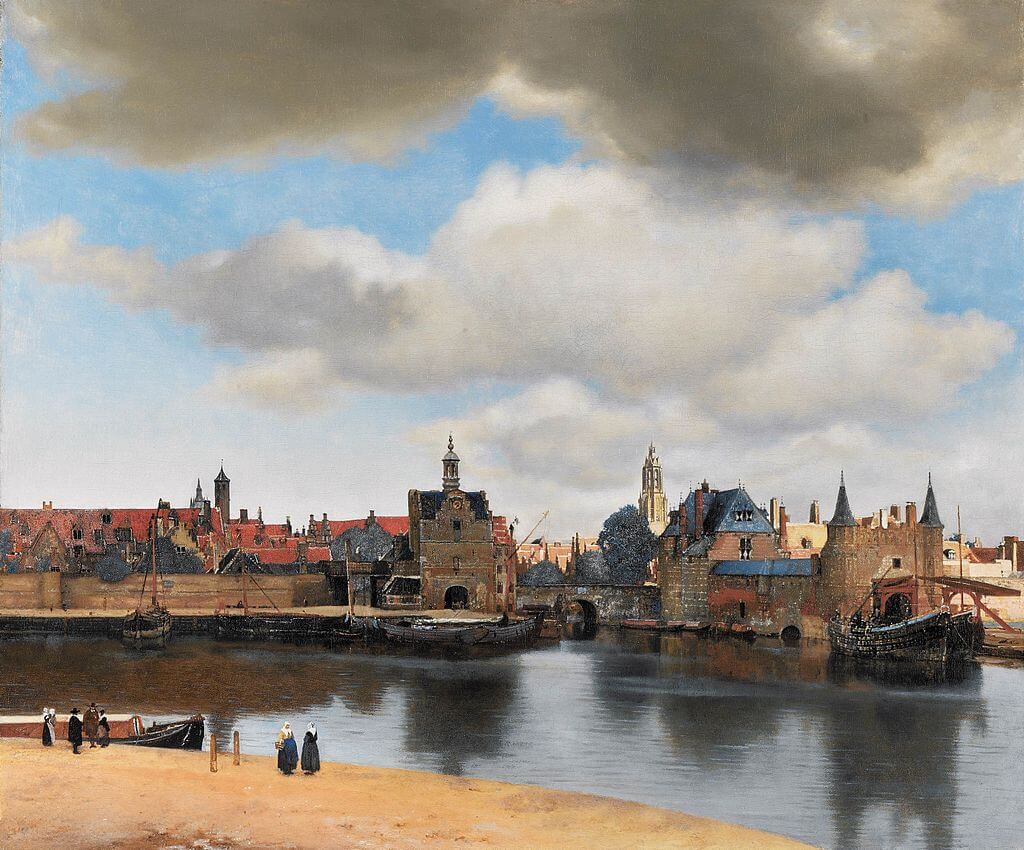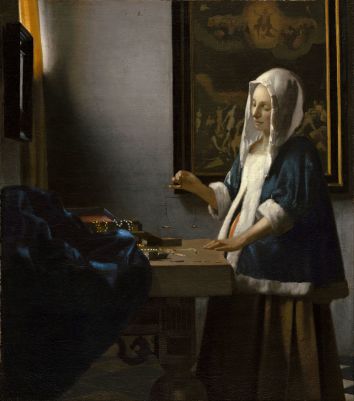|
Where? Prints are part of the collections of several museum around the world, including the Ashmolean Museum, National Gallery of Art, National Galleries Scotland, Philadelphia Museum of Art, and the Rijksmuseum.
When? 1581 What? Engraving on laid paper: plate: 30.6 x 20.8 cm; sheet: 54.2 x 42.9 cm. What do you see? A young nude boy sits on a pile of rocks, intently focused on removing a thorn from his bare foot. The statue sits in the corner of a room or foyer. Puffy clouds visible in the upper part of the window on the left help to define the available light source. Engraving techniques produce the textures that indicate the depth of the walls and the space the statue occupies. Each shadow is created by a multitude of fine lines, overlapping lines, and cross-hatching. The marble pedestal supporting the statue raises the young boy so the viewer can see the scene from below. His right foot does not touch the ground or rest as he tries to remove this thorn without inflicting more pain. The story and original sculpture date back to a Classical Roman marble that is said to be a copy of an even earlier Grecian bronze rendition lost in the 3rd century B.C. Reproductions of the statue were one of Rome's most widely admired antiquities, and drawings and prints were popular and in demand. A copy of the original ancient statue can be found at Palazzo dei Conservatori, which is part of the Capitoline Museums in Rome. It is recorded as having been there since 1499-1500.
0 Comments
Where? The Eregallerij on the second floor of the Rijksmuseum
When? 1668 What do you see? A happy household in a messy living room. The mother is sitting in the middle of the table and holds a young child on her lap. She is singing with her own mother next to her and shows a large amount of cleavage. The father on the left of the table is singing loudly as well and raises his glass while holding a violin in his left hand. The boy outside the window is smoking a pipe while he is holding a horn in his right hand. In the foreground, the young boy in green is drinking wine, which is provided to him by his sister who is holding a jug of wine. Both of them look older than their height would indicate. Two other children are playing music. The boy on the right with the red hat is playing the flute, and the boy in the left background is playing a kind of bagpipes. On the right background, a boy and a girl are holding pipes with tobacco. The dog is standing in front of the table which is filled with bread and meat, and he hopes that some of the food will fall off. The floor in the living room is messy, and we can identify a frying pan, half an eggshell, a large bowl, two jugs and a spoon. In contrast, the objects on top of the painting are neatly organized. On the top right, Steen included a piece of paper stating: ‘“Soo d’ oude Songen, Soo Pypen de Jonge.’ This means ‘As the Old Sing, So Pipe the Young.’ Backstory: Jan Steen sometimes used his own family as models for some people in his paintings, and it is suggested that some of the children in this painting are modeled after his kids. Steen created quite some paintings of families or groups of people in a messy environment. These paintings were not necessarily a realistic depiction of life in The Netherlands during the 17th century, but for Steen, it was a way in which he could include his style of humor and irony, but still provide a moral message. For example, some comparable paintings to The Merry Family are As the Old Sing, So Pipe the Young in the Mauritshuis in The Hague and The Feast of Saint Nicholas in the Rijksmuseum.
Moral message: Steen usually included a moral message in his paintings and he more often used children to convey this message. The behavior of the children in this painting is not intended to make you laugh, but to make you evaluate the behavior of their parents.
The message written on the piece of paper emphasizes that as it mentions that children are just copying the behavior of their parents. This message refers to the behavior of both parents and the grandmother, but primarily to the mother as, during that time, she was the main responsible for the moral values in the family. So, the moral message of this painting is that the people should be careful in the way they behave as it may have a big impact on (their) children. Who is Steen? Jan Havickszoon Steen (1626-1679) was born in Leiden in The Netherlands. During his life, he lived in various other Dutch cities, including The Hague, Delft, Warmond, and Haarlem. While Jan Steen also painted biblical, historical, and mythological scenes, his most popular works are the scenes from daily life. Steen is known for his humoristic style of painting, and he often included a moral message in his paintings, sometimes based on proverbs from his time. He is also considered to be an expert in accurately incorporating light into his paintings. While Steen has not had any known pupils, two of his sons were painters, but none of their works have survived. Fun fact: In Dutch, there is an expression for a messy and cluttered interior, which is still used nowadays. The Dutch expression is ‘een huishouden van Jan Steen’, which means ‘a Jan Steen household’. The people living in such a household are often depicted as happy people, just like in this painting. Jan Steen created quite some paintings that show these messy scenes, either depicting a family household in the living room or a group of people in a tavern. Jan Steen's messy households are in stark contrast to the very calm and organized paintings by his contemporary Johannes Vermeer, known of paintings such as Girl with a Pearl Earring in the Mauritshuis and The Milkmaid, which is also in the Rijksmuseum.
Where? The Nachtwachtzaal in the Eregallerij on the second floor of the Rijksmuseum
When? 1642 Commissioned by? The Guild of the Sharp Shooters under the command of Captain Frans Banning Cocq What do you see? The Amsterdam Guild of the Sharp Shooters which consists of eighteen people. The painting is full of action and movement. In the center, you can see Captain Frans Banning Cocq (the man with the black hat) and his lieutenant Ruytenburch (dressed in white) stepping into the light. The captain is dressed in an elegant black outfit with a red sash. He holds a cane and a glove in his right hand and stretches his left arm forward to indicate that the guild members should start marching. The lieutenant indicates with the lance in his left hand the direction in which they should march. On the right, the drummer confirms that the guild should start marching by hitting the drum. The other men are grabbing their weapons, which include muskets, lances, and pikes. Behind the young girl to the left of the captain is the flag carrier. On the complete left of the painting is the sergeant who is carrying a, so-called, halberd. The man in red is filling his musket with gunpowder. In between the captain and the lieutenant is a man firing his weapon (you can just see the smoke to the left of the hat of the lieutenant).
Over the years, the paint in this work became darker, and that is the reason that in the 18th century the painting was called The Night Watch. However, there is no clear evidence that this scene is set in the night.
This is the largest painting by Rembrandt. It cost the guild at least 1600 guilders and each member contributed their share of money to pay Rembrandt. Not all members of the guild were happy with the final painting. The captain and his lieutenant were obviously happy with their prominent position, but the other members were not as happy as they were shown in the dark. In 1715, the painting was moved from its original location, and pieces from each side of the painting were cut off, whereby the painting lost about 20% of its original size. A copy of the Night Watch by Gerrit Lundens provides an indication of the missing pieces.
In his personal life, Rembrandt suffered a lot of setbacks. For example, around the time that this painting was finished, the wife of Rembrandt died. However, this did not affect his productivity as in the following years he seemed more productive than ever. He also lost three children shortly after birth.
Rembrandt was able to create a wide range of different paintings, including genre paintings, biblical paintings, mythological paintings, landscapes, and even animal paintings. Some other well-known works by Rembrandt include Saul and David and The Anatomy Lesson of Dr. Nicolaes Tulp, which are both in the Mauritshuis in The Hague.
Fun fact: The painting has been damaged on several occasions over time.
Interested in a copy for yourself? Poster or canvas (Amazon links)
CC BY-SA 3.0 NL Nationaal Archief
Where? The Eregallerij on the second floor of the Rijksmuseum
When? Between 1657 and 1661 What do you see? A milkmaid is pouring milk from an earthenware jug into an earthenware cooking pot. The table is covered with a greenish cloth, and a blue cloth is hanging down from the table. The table further contains various pieces of bread, a basket with bread, and a blue stoneware jug (note the use of small bright dots by Vermeer on the bread baskets and the bread – also referred to as the pointillé technique). The girl is possibly making bread pudding in the cooking pot. She is focused on her task, and her face is expressionless. She is dressed in a white linen cap, a yellow jacket of wool, rolled-up green and blue sleeves that are not part of her jacket, a blue apron, and a red skirt. The sunlight is entering through the window on the left. Note that one piece of the glass on the right is broken. To the right of the window hangs a basket with bread on the wall. Above the basket hangs a small painting with unknown content and to the right of the basket hangs a metal container. The large wall in the back is white (with some stains) and lit up by the sunlight which enters through the window. At the bottom of this wall is a series of typical Delft Blue tiles. In front of these tiles is a foot stove to warm the feet with nine holes on the top and a bowl inside of it. The tile on the left of the stove depicts Cupid. The tile on the right of the stove depicts a man with a long walking stick. Treatment of Light? The way that Vermeer included the effects of the sunlight in this painting is particularly noteworthy. The light is most visible when looking at the walls. The wall on the left is in the shadow, and the back wall is largely lit up. You can also see various shadows on the back wall. An obvious one is the shadow of the metal container on the left of the back wall. While the window is only partially included, we can get a good idea of its real size by looking at the presence of the shadows or the lack thereof. For example, we do not see the shadow of the milkmaid, indicating that the window does not extend much to the left. However, we can see the shadow of the nail on the top of the painting (above the right shoulder of the milkmaid) indicating that the window is quite tall. Backstory: About twenty years after the death of Vermeer, 21 of his paintings were sold at an auction. This painting was sold for 175 guilders in 1696 (which is roughly equivalent to $90 at that time). After the View of Delft painting (which is now in the Mauritshuis in The Hague), it was the second most expensive painting sold during that auction and considered to be a great piece of work. The next most expensive painting was Woman Holding a Balance which is now in the National Gallery of Art in Washington, DC. The Milkmaid was acquired in 1908 by the Rijksmuseum. Recent x-ray examinations have shown that Vermeer removed a couple of items from the painting. First, Vermeer initially included a painting on the back wall. However, as paintings were quite expensive at that time, he removed it to create an empty wall to simplify the room. Second, he also initially included a clothing basket next to the bottom right of the woman’s red skirt, but he also removed this later on. He probably removed this basket to put more emphasis on the main theme of this painting and not to distract the viewer too much.
Who is Vermeer? Johannes Vermeer (1632-1675) spend his full life in Delft in The Netherlands. He is considered to be a genre painter as he uses scenes from everyday life as the theme for his paintings. Vermeer was a perfectionist and worked for months on a single painting. His work is admired because of its great harmony. He was also an expert in incorporating light into his paintings and is sometimes referred to as the ‘Master of Light’.
While Vermeer's work was appreciated during his life, Vermeer was largely forgotten after his death. It took until the second half of the 19th century for Vermeer to be rediscovered. Especially the Impressionist painters could appreciate his usage of light, and since then Vermeer has gradually become more popular again. Without a doubt, his most famous work is the Girl with a Pearl Earring in the Mauritshuis in The Hague.
What is genre art? Vermeer is considered to be genre painter. Genre art is the depiction of scenes from everyday life, such as domestic settings, markets, and life on the streets. It evolves around depicting the common people engaged in daily activities.
Genre art was popular in the 16th and especially the 17th century in Flanders and The Netherlands. Pieter Bruegel the Elder and Jan Steen are two other examples of well-known genre painters. Fun fact: The woman in this painting is not really a milkmaid. While she is pouring milk at this particular moment, she is probably a kitchen maid or a servant. A milkmaid was actually someone who milked the cows and used the milk to produce dairy products. The term milkmaid is not to be confused with the milkman, who was someone who would deliver the milk to the houses of people. Some people interpret the milkmaid in this painting in an erotic way. During Vermeer’s time, milkmaids were often considered to be a subject of male desire and they were often sexually available to their employer. These people argue that the open jug of milk, the foot stove to warm up the feet and everything under the skirt of the milkmaid, and a Delft Blue tile depicting Cupid are all subtle signs of eroticism. Interested in a copy for yourself? Poster |
Categories
All
|
- Home
- Blog
-
Museums
- Alte Pinakothek
- Art Institute of Chicago
- Baltimore Museum of Art
- Barber Institute of Fine Arts
- Bargello
- Barnes Foundation
- British Museum
- Church of Sant’Anastasia
- Cleveland Museum of Art
- Courtauld Institute of Art
- Detroit Institute of Arts
- Frans Hals Museum
- Galleria Borghese
- Gallerie dell'Accademia
- Getty Museum
- Guggenheim
- Hermitage Museum
- Kunsthistorisches Museum
- Kunstmuseum Basel
- Legion of Honor Museum
- Louvre
- Mauritshuis
- Metropolitan Museum of Art
- Musee d’Orsay
- Museum of Fine Arts in Boston
- Museum of Modern Art
- National Gallery in London
- National Gallery of Art
- National Museum in Poznań
- Norton Simon Museum
- Ny Carlsberg Glyptotek
- Palace of Versailles
- Palazzo Pitti
- Palazzo Vecchio
- Petit Palais
- Philadelphia Museum of Art
- Prado
- Pushkin Museum
- Ravenna Art Museum
- Rijksmuseum
- San Diego Museum of Art
- Santa Maria delle Grazie
- St. Peter's Basilica
- Städel Museum
- Statens Museum for Kunst
- Tate Britain
- Tate Modern
- Timken Museum of Art
- Uffizi
- Vatican Museums
- Wallace Collection
-
Artists
- Altdorfer
- Anguissola
- Berlin Painter
- Bosch
- Botticelli
- Boucher
- Bronzino
- Bruegel the Elder
- Brunelleschi
- Cabanel
- Caillebotte
- Canova
- Caravaggio
- Carpeaux
- Cezanne
- Cimabue
- David
- Degas
- Delacroix
- De Maria
- Donatello
- El Greco
- Fontana
- Fra Angelico
- Fragonard
- Gauguin
- Gentileschi
- Gericault
- Gonzalez-Torres
- Goya
- Hals
- Hogarth
- Hokusai
- Ingres
- Leonardo da Vinci
- Lippi, Filippo
- Longhi, Barbara
- Lorrain
- Makovsky
- Manet
- Massys
- Matisse
- Merian
- Michelangelo
- Mochi
- Modigliani
- Monet
- Panini
- Parmigianino
- Perugino
- Picasso
- Pisanello
- Raphael
- Rembrandt
- Renoir
- Reynolds
- Rivera
- Rodin
- Rubens
- Scultori
- Seurat
- Steen
- Tintoretto
- Titian
- Toulouse-Lautrec
- Turner
- Uccello
- Van der Weyden
- Van Dyck
- Van Eyck
- Van Gogh
- Van Hemessen
- Vasari
- Velazquez
- Vermeer
- Veronese
- Vigée Le Brun
-
Locations
- Books
- About Us


